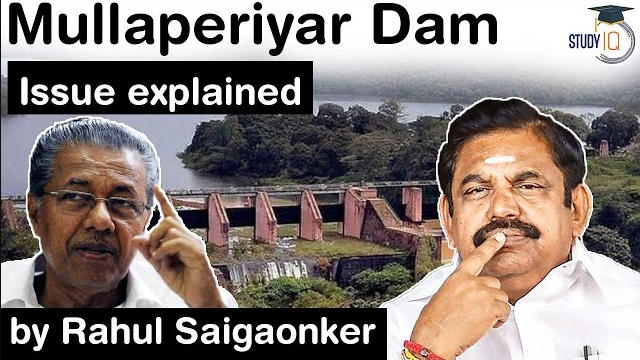Table of Contents
The News
- Recently, The Supreme Court has issued notices to the central government, state government of Kerala and Tamil Nadu on a plea seeking termination of Mullaperiyar’s 1886 lease agreement.
- SC said the petition seeking cancellation of lease agreement will be considered along with the petition against Mullaperiyar supervising committee on April 22 2021.
The 999 blunder
- Mullaperiyar dam is on the Periyar River, which originates in the Western Ghats of Kerala and flows across the state to join the Arabian Sea.
- It was built in 1895 by Madras State, now Tamil Nadu, under the British rule.
- The British government had struck a lease agreement with the princely state of Travancore, now part of Kerala, to lease around 3,500 hectares (ha) to Madras and grant it all rights over the reservoir water for irrigation for 999 years.
The Mullaperiyar problem
The issue
- Since 1895, Tamil Nadu has been controlling and managing the dam and diverting the reservoir water for irrigating its drought-prone Madurai, Theni, Sivaganga, Ramanathapuram and Dindigul districts.
- Every year, on an average, the state diverts 606.83 million cubic metres of water to irrigate around 70,000 ha. It also uses the water to produce 140 MW power.
The issue
- The two states were cordial until 1979 when the dam developed cracks and started leaking, raising doubts about its safety. The dam was over 80 years old then.
- The Central Water Commission visited the dam and recommended lowering the maximum water level in the reservoir to 41.45 metres (136ft) and carry out strengthening works.
- Tamil Nadu spent Rs 26 crore on strengthening the dam by constructing a 10-metre-wide concrete backing and on other safety repairs.
The timeline
- The Kerala Government highlighted that “mistakes in the strengthening works carried out by Tamil Nadu” in 1979 damaged the masonry of the dam further.
- The problem area
- The dam was constructed from limestone and “surkhi” (burnt brick powder and a mixture of sugar and calcium oxide ).
- This makes it tough for gauging the health of dam. Different studies suggest different results.
The timeline
- In 2000, Expert Committee under CWC with representatives from both States was constituted.
- The Committee opined that with the strengthening measures implemented, the water level can be raised from 136 ft. To 142 ft. without endangering safety of the dam.
- In 2006, Government of Kerala passed the Kerala Irrigation and Water Conservation (Amendment) Act 2006 which prohibited the raising of water level beyond 136 ft. in the Mullaperiyar Dam and placed it in the Schedule of ‘Endangered Dams’.
The timeline
- In 2010, SC decided to constitute a five-member empowered committee to study all the issues of Mullaperiyar Dam and seek a report from it within six months.
- The Empowered Committee, headed by the former Chief Justice of India A.S. Anand in 2012, said the dam is “structurally and hydrologically safe, and Tamil Nadu can raise the water level from 136 to 142 feet after carrying out certain repairs.”
- Empowered Committee in its report suggested two alternatives:
- First alternative is that Kerala could construct a new Dam and the existing dam may not be dismantled, demolished or decommissioned till the new dam construction is completed and it becomes operational.
- The second alternative is to repair, strengthen/ restore the existing dam.
The timeline
- In 2014, the court constituted a supervising committee to supervise and carry out works to keep the 125 years old dam safe.
- In 2018, The Central water commission issued the updated ‘Guidelines for Preparing Operation and Maintenance Manual of Dams’ which has not been complied by the State of Tamil Nadu.
- It was submitted there was failure of State of Tamil Nadu to carry out construction of an evacuation tunnel at low level to make possible evacuation of water in the event of a distress to the 125 years old Mullaperiyar Dam, as prescribed mandatory in the ‘Guidelines for Preparing Operation and Maintenance Manual of Dams’.
Latest development
- In July 2020, the Suraksha Public Charitable Trust approached the Supervising Committee to know about the progress of repair work. (Dismissed)
- In August 2020, the Suraksha Public Charitable Trust approached State of Kerala to construct a protection wall as recommended by the Geologoical Survey of India to save human lives in the event of dam break. (No Progress)
- In October 2020, the Suraksha Public Charitable Trust filed a writ petition before Kerala High Court, seeking an appropriate direction to the State of Tamil Nadu to terminate lease deed, and to initiate the necessary steps for the construction of the protection wall. (Dismissed)
Latest development
- Now, a writ petition has been filed by the Suraksha Public Charitable Trust requesting the apex court to recommend Kerala government to revoke the 1886 lease agreement if Tamil Nadu violates the directions of the Constitutional Bench issued in 2014.
- The petitioner submitted to SC has highlighted that there were major lapses on the part of respective respondents in taking due care as is required in issues like water bomb.
- The petitioner has also alleged that the supervisory committee was evading the responsibilities given by the constitution bench.
Latest Burning Issues | Free PDF

























 WhatsApp
WhatsApp